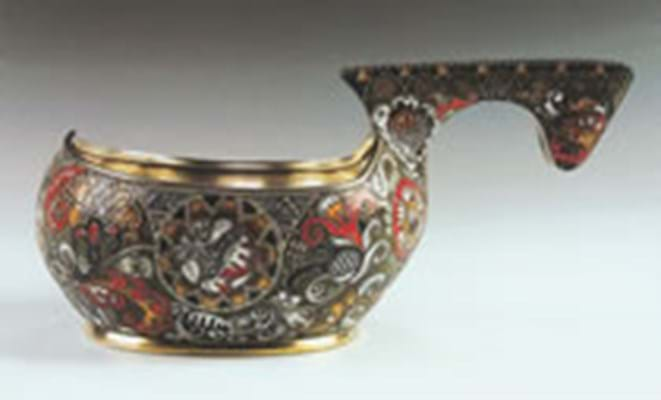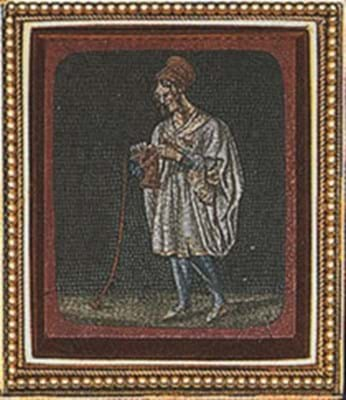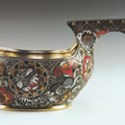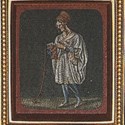Lyon & Turnbull
Buyers Premium 19.5/12%
The £14,000 achieved by a Fabergé locket at Lyon & Turnbull last December resulted in a number of supposedly Fabergé pieces being offered to the May sale by would-be vendors but the Edinburgh firm's specialist Emma Macmillan ruled most not to be genuine and they were not offered.
However, a piece chanced upon by fellow specialist Trevor Kyle on a routine valuation was a different matter. It was among some Pyrex kitchen bowls but it appeared to be an early 20th century cloisonne enamelled Fabergé kovsch. The first thing Mr Kyle did was to get the marks for the Fabergé Moscow workshop c.1907-1918 authenticated.
From 1877 Fedor Ruckert supplied the Moscow branch of the Fabergé firm with cloisonne enamel products and it turned out that this kovsch was one of the celebrated enameller's creations and employed his distinctive muted colour palette.
The exterior of the 15in (37cm) long, 63/4in (17.5cm) high vessel was decorated with a bold pattern of stylised floral, geometric and scroll designs in shades of white, ochre, orange, black and olive green enamels. It had a gilt interior and a scratch inventory number to the base.
The quality of the workmanship attracted widespread interest from London, American and Russian dealers. A Russian-born American private buyer on the telephone clinched the kovsch, bidding £40,000 against an estimate of £8000-12.000.
Speaking to the auctioneers after the sale, the buyer, who has been collecting Russian art for 30 years, said: "I knew as soon as I saw the bowl that I had to have it. I have a large collection of Russian art. The bowl is one of the best examples of Ruckert's work and is of museum quality."
Nearer to home, Lyon & Turnbull have a reputation for consignments of Scottish provincial silver.
However, although the firm have hopes of a sizeable private dispersal for their next jewellery and silver outing, on this occasion buyers had to make do with a fairly thin 12-lot offering.
Nevertheless, the section included some interesting pieces with the foremost entry a pair of serving spoons by James Gordon with marks for Aberdeen c.1775.
The fact they were serving spoons, rather than tablespoons, had good clean marks and bore crests, possibly relating to Aberdeen's aristocratic Gordon family, made them a must for several collectors. The pair realised £1200.
Elsewhere, speculation that an undated Aberdeen silver mounted coconut cup carved with a pineapple palm tree, rose, shamrock and thistle, and stamped ABD only, was late 18th or early 19th century helped it top expectations at £500. Demand remained steady for novelties and other small pieces of collectable silver included a London-marked, oval shoot counter by Henry William Dee dating to c.1868.
It was fitted to each side with three dials inscribed Partridges, Snipes, Rabbits, Pheasants, Woodcocks, and Hares. Significantly, all of the dials were in good working order. It attracted private and trade interest with the winner going to £2800 for this ultimate Victorian gentleman's gadget.
The earliest piece of silver was an Elizabeth 1 Communion cup with marks for London 1577 and a maker's mark of an orb and cross. The 7oz, privately consigned, cup was plainly engraved with a scrollwork band and stood on a waisted knopped column with a trumpet foot. A dealer secured it at £5900.
Among the most substantial pieces of silver was an 1830, London-made (probably by William Eley I) claret jug weighing 75oz.
The 2ft 63/4in (78cm) high vessel was decorated all over in the Renaissance manner and inscribed From Major Sir Walter Scott, Charles Scott & Sophia Lockhart to Robert Ferguson M.D. 1833. Whether or not the inscription referred to the celebrated Scottish novelist and poet, a Scottish private buyer thought it was good enough quality to bid £4000 for ownership.
While the silver section boasted a healthy 84 per cent take-up by volume, bidding was more selective for the 142-lot jewellery section that was only 60 per cent sold by lot and fielded the two highest profile casualties: a 10.05ct diamond ring that failed to sell at £60,000-80,000 and a 6ct diamond ring unsold against hopes of £35,000-40,000.
However, a finely worked micromosaic brooch met with a more enthusiastic reception. The rectangular brooch with bead and rope-twist borders measuring 11/2 x 1in (4 x 3cm) depicted a woman knitting and was stamped to the reverse Mrs N.
Although it was undated in the catalogue and given a modest £500-700 guideline, it was in good condition and caught the attention of American, Italian and UK buyers.
It sold at £3000 to a buyer presumably confident it was an 18th century piece.
A genuine Fabergé kovsch comes fresh from the kitchen…
LIKE so much material where the name is so much part of the game, the exquisite objets d’art fashioned in the Russian workshops of Carl Fabergé have attracted copyists, repro-producers and outright forgers.










